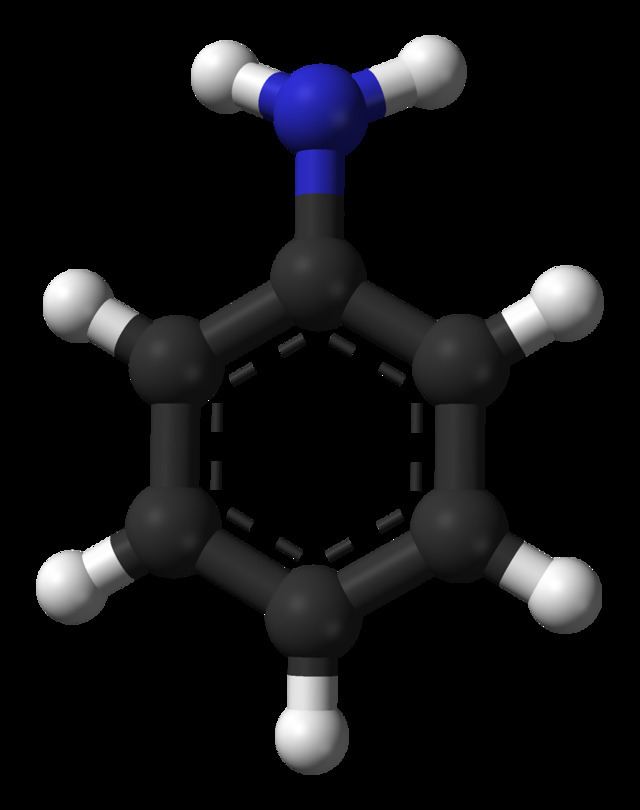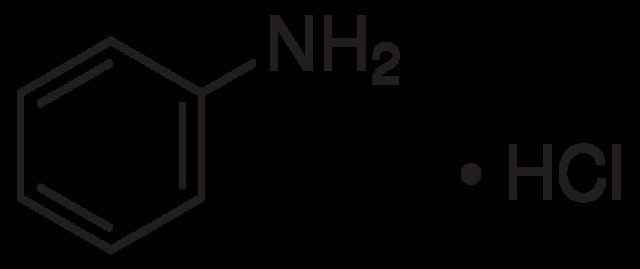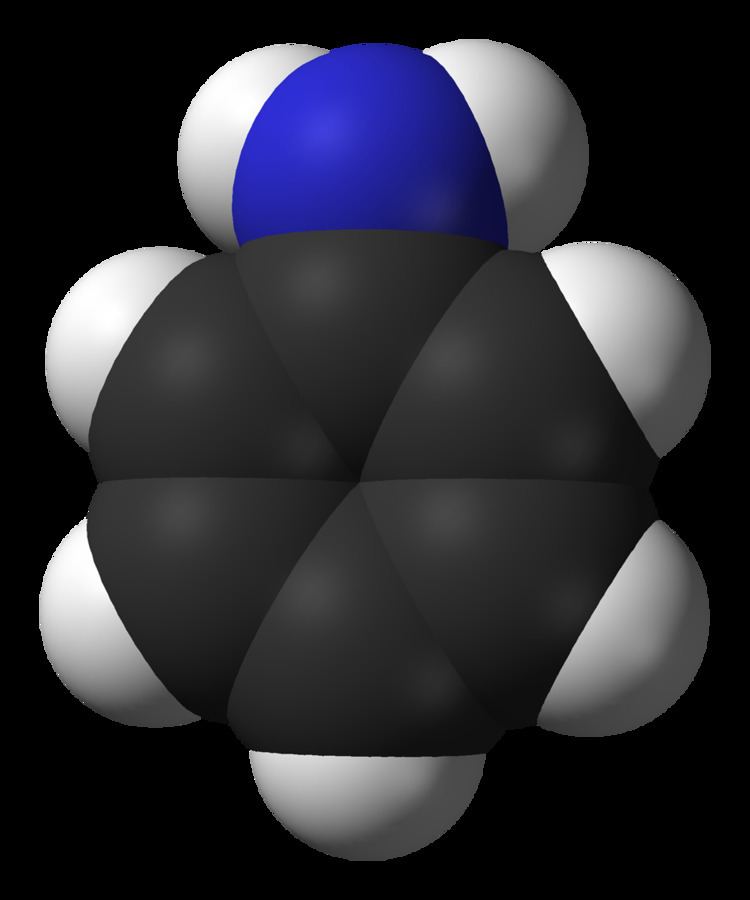Formula C6H5NH2 Boiling point 184.1 °C IUPAC ID Phenylamine Classification Aromatic amine | Molar mass 93.13 g/mol Density 1.02 g/cm³ Melting point -6.3 °C | |
 | ||
Appearance Colorless to yellow liquid Related compounds Thermodynamicdata Phase behavioursolid–liquid–gas | ||
Analysis of organic compound aniline
Aniline is an organic compound with the formula C6H5NH2. Consisting of a phenyl group attached to an amino group, aniline is the prototypical aromatic amine. Its main use is in the manufacture of precursors to polyurethane and other industrial chemicals. Like most volatile amines, it possesses the odour of rotten fish. It ignites readily, burning with a smoky flame characteristic of aromatic compounds.
Contents
- Analysis of organic compound aniline
- Structure
- Production
- Related aniline derivatives
- Reactions
- Oxidation
- Electrophilic reactions at carbon
- Basicity
- Acylation
- N Alkylation
- Carbon disulfide derivatives
- Diazotization
- Other reactions
- Uses
- History
- Synthetic dye industry
- Developments in medicine
- Rocket fuel
- Toxicology and testing
- References
Structure

Aniline is a planar molecule. The amine is nearly planar owing to conjugation of the lone pair with the aryl substituent. The C-N distance is correspondingly shorter. In aniline, the C-N and C-C distances are close to 1.39 Å, indicating the π-bonding between N and C.
Production

Industrial aniline production involves two steps. First, benzene is nitrated with a concentrated mixture of nitric acid and sulfuric acid at 50 to 60 °C to yield nitrobenzene. The nitrobenzene is then hydrogenated (typically at 200–300 °C) in the presence of metal catalysts.

The reduction of nitrobenzene to aniline was first performed by Nikolay Zinin in 1842 using inorganic sulfide as a reductant (Zinin reaction).
Aniline can alternatively be prepared from ammonia and phenol derived from the cumene process.

In commerce, three brands of aniline are distinguished: aniline oil for blue, which is pure aniline; aniline oil for red, a mixture of equimolecular quantities of aniline and ortho- and para-toluidines; and aniline oil for safranine, which contains aniline and ortho-toluidine, and is obtained from the distillate (échappés) of the fuchsine fusion.
Related aniline derivatives

Many analogues of aniline are known where the phenyl group is further substituted. These include toluidines, xylidines, chloroanilines, aminobenzoic acids, nitroanilines, and many others. They often are prepared by nitration of the substituted aromatic compounds followed by reduction. For example, this approach is used to convert toluene into toluidines and chlorobenzene into 4-chloroaniline.
Reactions

The chemistry of aniline is rich because the compound has been cheaply available for many years. Below are some classes of its reactions.
Oxidation

The oxidation of aniline has been heavily investigated, and can result in reactions localized at nitrogen or more commonly results in the formation of new C-N bonds. In alkaline solution, azobenzene results, whereas arsenic acid produces the violet-coloring matter violaniline. Chromic acid converts it into quinone, whereas chlorates, in the presence of certain metallic salts (especially of vanadium), give aniline black. Hydrochloric acid and potassium chlorate give chloranil. Potassium permanganate in neutral solution oxidizes it to nitrobenzene, in alkaline solution to azobenzene, ammonia and oxalic acid, in acid solution to aniline black. Hypochlorous acid gives 4-aminophenol and para-amino diphenylamine. Oxidation with persulfate affords a variety of polyanilines compounds. These polymers exhibit rich redox and acid-base properties.
Electrophilic reactions at carbon

Like phenols, aniline derivatives are highly susceptible to electrophilic substitution reactions. Its high reactivity reflects that it is an enamine, which enhances the electron-donating ability of the ring. For example, reaction of aniline with sulfuric acid at 180 °C produces sulfanilic acid, H2NC6H4SO3H.

If bromine water is added to aniline, the bromine water is decolourised and a white precipitate of 2,4,6-tribromophenylamine is formed. The largest scale industrial reaction of aniline involves its alkylation with formaldehyde. An idealized equation is shown:
2 C6H5NH2 + CH2O → CH2(C6H4NH2)2 + H2OThe resulting diamine is the precursor to 4,4'-MDI and related diisocyanates.
Basicity
Aniline is a weak base. Aromatic amines such as aniline are, in general, much weaker bases than aliphatic amines. Aniline reacts with strong acids to form anilinium (or phenylammonium) ion (C6H5-NH3+).
Traditionally, the weak basicity of aniline is attributed to a combination of inductive effect from the more electronegative sp2 carbon and resonance effects, as the lone pair on the nitrogen is partially delocalized into the pi system of the benzene ring. Missing in such analysis is consideration of solvation. Aniline is, for example, more basic than ammonia in the gas phase, but ten thousand times less so in aqueous solution.
Acylation
Aniline reacts with acyl chlorides such as acetyl chloride to give amides. The amides formed from aniline are sometimes called anilides, for example CH3-CO-NH-C6H5 is acetanilide. At high temperatures aniline and carboxylic acids react to give the anelide.
N-Alkylation
N-Methylation of aniline with methanol at elevated temperatures over acid catalysts gives N-methylaniline and dimethylaniline:
C6H5NH2 + 2 CH3OH → C6H5N(CH3)2 + 2H2ON-Methylaniline and dimethylaniline are colorless liquids with boiling points of 193–195 °C and 192 °C, respectively. These derivatives are of importance in the color industry. Aniline combines directly with alkyl iodides to form secondary and tertiary amines.
Carbon disulfide derivatives
Boiled with carbon disulfide, it gives sulfocarbanilide (diphenylthiourea) (CS(NHC6H5)2), which may be decomposed into phenyl isothiocyanate(C6H5CNS), and triphenyl guanidine (C6H5N=C(NHC6H5)2).
Diazotization
Aniline and its ring-substituted derivatives react with nitrous acid to form diazonium salts. Through these intermediates, aniline can be conveniently converted to -OH, -CN, or a halide via Sandmeyer reactions. This diazonium salt can also be reacted with NaNO2 and phenol which produces a dye which is benzeneazophenol, this process is called coupling.
Other reactions
It reacts with nitrobenzene to produce phenazine in the Wohl-Aue reaction. Hydrogenation gives cyclohexylamine.
Being a standard reagent in laboratories, aniline is used for many niche reactions. Its acetate is used in the Aniline acetate test for carbohydrates, identifying pentoses by conversion to furfural. It is used to stain neural RNA blue in the Nissl stain.
Uses
The largest application of aniline is for the preparation of methylene dianiline and related compounds by condensation with formaldehyde (as discussed above). The diamines are condensed with phosgene to give methylene diphenyl diisocyanate, a precursor to urethane polymers. Other uses include rubber processing chemicals (9%), herbicides (2%), and dyes and pigments (2%). As additives to rubber, aniline derivatives such as phenylenediamines and diphenylamine, are antioxidants. Illustrative of the drugs prepared from aniline is paracetamol (acetaminophen, Tylenol). The principal use of aniline in the dye industry is as a precursor to indigo, the blue of blue jeans.
Aniline is also used at a smaller scale in the production of the intrinsically conducting polymer polyaniline.
History
Aniline was first isolated in 1826 by Otto Unverdorben by destructive distillation of indigo. He called it Crystallin. In 1834, Friedlieb Runge isolated a substance from coal tar that turned a beautiful blue color when treated with chloride of lime. He named it kyanol or cyanol. In 1840, Carl Julius Fritzsche (1808–1871) treated indigo with caustic potash and obtained an oil that he named aniline, after an indigo-yielding plant, Añil (Indigofera suffruticosa). In 1842, Nikolay Nikolaevich Zinin reduced nitrobenzene and obtained a base that he named benzidam. In 1843, August Wilhelm von Hofmann showed that these were all the same substance, known thereafter as phenylamine or aniline.
Synthetic dye industry
In 1856, whilst trying to synthesise quinine, von Hofmann's student William Henry Perkin discovered mauveine and went into industry producing the first synthetic dye. Other aniline dyes followed, such as fuchsine, safranine, and induline. At the time of mauveine's discovery, aniline was expensive. Soon thereafter, applying a method reported in 1854 by Antoine Béchamp, it was prepared "by the ton". The Béchamp reduction enabled the evolution of a massive dye industry in Germany. Today, the name of BASF, originally Badische Anilin- und Soda-Fabrik (English: Baden Aniline and Soda Factory), now among the largest chemical suppliers, echoes the legacy of the synthetic dye industry, built via aniline dyes and extended via the related azo dyes. The first azo dye was aniline yellow.
Developments in medicine
In the late 19th century, aniline emerged as an analgesic drug, its cardiac-suppressive side effects countered with caffeine. During the first decade of the 20th century, while trying to modify synthetic dyes to treat African sleeping sickness, Paul Ehrlich – who had coined the term chemotherapy for his magic bullet approach to medicine – failed and switched to modifying Béchamp's atoxyl, the first organic arsenical drug, and serendipitously obtained a treatment for syphilis – salvarsan – the first successful chemotherapy agent. Salvarsan's targeted microorganism, not yet recognized as a bacterium, was still thought to be a parasite, and medical bacteriologists, believing that bacteria were not susceptible to the chemotherapeutic approach, overlooked Alexander Fleming's report in 1928 on the effects of penicillin.
In 1932, Bayer sought medical applications of its dyes. Gerhard Domagk identified as an antibacterial a red azo dye, introduced in 1935 as the first antibacterial drug, prontosil, soon found at Pasteur Institute to be a prodrug degraded in vivo into sulfanilamide – a colorless intermediate for many, highly colorfast azo dyes – already with an expired patent, synthesized in 1908 in Vienna by the researcher Paul Gelmo for his doctoral research. By the 1940s, over 500 related sulfa drugs were produced. Medications in high demand during World War II (1939–45), these first miracle drugs, chemotherapy of wide effectiveness, propelled the American pharmaceutics industry. In 1939, at Oxford University, seeking an alternative to sulfa drugs, Howard Florey developed Fleming's penicillin into the first systemic antibiotic drug, penicillin G. (Gramicidin, developed by René Dubos at Rockefeller Institute in 1939, was the first antibiotic, yet its toxicity restricted it to topical use.) After World War II, Cornelius P. Rhoads introduced the chemotherapeutic approach to cancer treatment.
Rocket fuel
In the 1940s and early 1950s, aniline was used with nitric acid or dinitrogen tetroxide as rocket fuel for small missiles and the Aerobee rocket. The two fuel components are hypergolic, producing a violent reaction on contact. Aniline was later replaced by hydrazine.
Toxicology and testing
Aniline is toxic by inhalation of the vapour, ingestion, or percutaneous absorption. The IARC lists it in Group 3 (not classifiable as to its carcinogenicity to humans) due to the limited and contradictory data available. The early manufacture of aniline resulted in increased incidents of bladder cancer, but these effects are now attributed to naphthylamines, not anilines.
Many methods exist for the detection of aniline.
